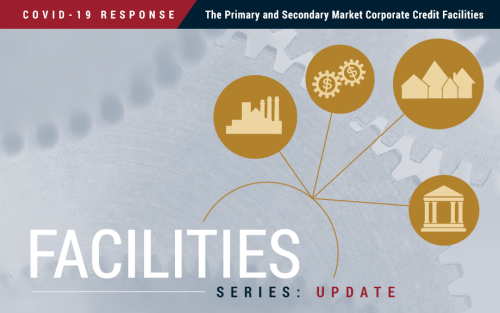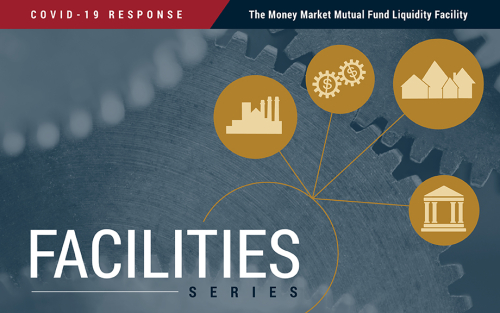Weathering the Storm: Who Can Access Credit in a Pandemic?
Credit enables firms to weather temporary disruptions in their business that may impair their cash flow and limit their ability to meet commitments to suppliers and employees. The onset of the COVID recession sparked a massive increase in bank credit, largely driven by firms drawing on pre-committed credit lines. In this post, which is based on a recent Staff Report, we investigate which firms were able to tap into bank credit to help sustain their business over the ensuing downturn.
The Impact of the Corporate Credit Facilities

American companies have raised almost $1 trillion in the U.S. corporate bond market since March. Based on Compustat data, these companies employ more than 16 million people, and have spent more than $280 billion on capital expenditures in the first half of 2020, thereby supporting future economic activity. In this post, we document the contribution of the Primary Market and Secondary Market Corporate Credit Facilities (PMCCF and SMCCF) to bond market functioning, summarizing a detailed evaluation described in a new working paper. Improvements documented in an earlier blog post on the corporate facilities continued after the initial announcement as purchases began, and can be attributed both to the positive effects of Federal Reserve interventions generally as well as the facilities’ direct impact on eligible issuers in particular.
MBS Market Dysfunctions in the Time of COVID‑19

Haoyang Liu, Asani Sarkar, and coauthors study a particular aspect of MBS market disruptions by showing how a long-standing relationship between cash and forward markets broke down, in spite of dealers increasing the provision of liquidity. The analysis also highlights an innovative response by the Federal Reserve that seemed to have helped to normalize market functioning.
Insider Networks

Erol and Lee consider the cat-and-mouse game played between financial regulators and those attempting to trade on inside information, including how insiders might form networks in order to circumvent restrictions, and how regulators might cope with insiders’ tactics.
Outflows from Bank‑Loan Funds during COVID‑19
The COVID-19 pandemic has put significant pressure on debt markets, especially those populated by riskier borrowers. The leveraged loan market, in particular, came under remarkable stress during the month of March. Bank-loan mutual funds, among the main holders of leveraged loans, suffered massive outflows that were reminiscent of the outflows they experienced during the 2008 crisis. In this post, we show that the flow sensitivity of the loan-fund industry to the COVID-19 crisis (and to negative shocks more generally) seems to be even greater than that of high-yield bond funds, which also invest in high-risk debt securities and have received much attention because of their possible exposure to run-like behavior by investors and their implications for financial stability.
How Fed Swap Lines Supported the U.S. Corporate Credit Market amid COVID‑19 Strains
The onset of the COVID-19 shock in March 2020 brought large changes to the balance sheets of the U.S. branches of foreign banking organizations (FBOs). Most of these branches saw sizable usage of committed credit lines by U.S.-based clients, resulting in increased funding needs. In this post, we show that branches of FBOs from countries whose central banks used standing swap lines with the Federal Reserve (“standing swap central banks”—SSCBs) met their increased funding needs by accessing dollars that flowed into the United States through their foreign parent banks. This volume of dollar inflows accounted for at least half of the late March aggregate take-up at SSCB dollar operations.
The Primary and Secondary Market Corporate Credit Facilities

On April 9, the Federal Reserve announced that it would take additional actions to provide up to $2.3 trillion in loans to support the economy in response to the coronavirus pandemic. Among the initiatives are the Primary Market and Secondary Market Corporate Credit Facilities (PMCCF and SMCCF), whose intent is to provide support for large U.S. businesses that typically finance themselves by issuing debt in capital markets. Corporate bonds support the operations of companies with more than 17 million employees based in the United States and these bonds are key assets for retirees and pension funds. If companies are unable to issue corporate bonds, they may be unable to invest in inventory and equipment, meet current liabilities, or pay employees. Maintaining access to credit is thus crucially important during the COVID-19 pandemic, both for issuing companies and for their employees. This post documents the dislocations in the corporate bond market that have motivated the creation of these facilities and explains how we expect these facilities to support U.S. businesses and their employees both through the COVID-related disruptions and beyond, when the economy recovers.
The Money Market Mutual Fund Liquidity Facility

To prevent outflows from prime and muni funds from turning into an industry-wide run after the COVID-19 outbreak, the Federal Reserve established Money Market Mutual Fund Liquidity Facility. This post looks at the Fed’s intervention, its goals, and the direct and indirect market effects.
How Does Supervision Affect Bank Performance during Downturns?

New research finds that there is a cyclical nature to the benefits of bank supervisory attention: in normal times, the benefits are smaller, but during downturns the more closely supervised banks exhibit better loan performance and lower earnings volatility.
The Value of Opacity in a Banking Crisis

During crisis periods, we often observe regulators limiting access to bank‑level information with the goal of restoring the public’s confidence in banks. Thus, information management often plays a central role in ending financial crises. Despite the perceived importance of managing information about individual banks during a financial crisis, we are not aware of any empirical work that quantifies the effect of such policies. In this blog post, we highlight results from our recent working paper, demonstrating that in a crisis, a policy of suppressing information about banks’ balance sheets has a significant and positive effect on deposits.














 RSS Feed
RSS Feed Follow Liberty Street Economics
Follow Liberty Street Economics